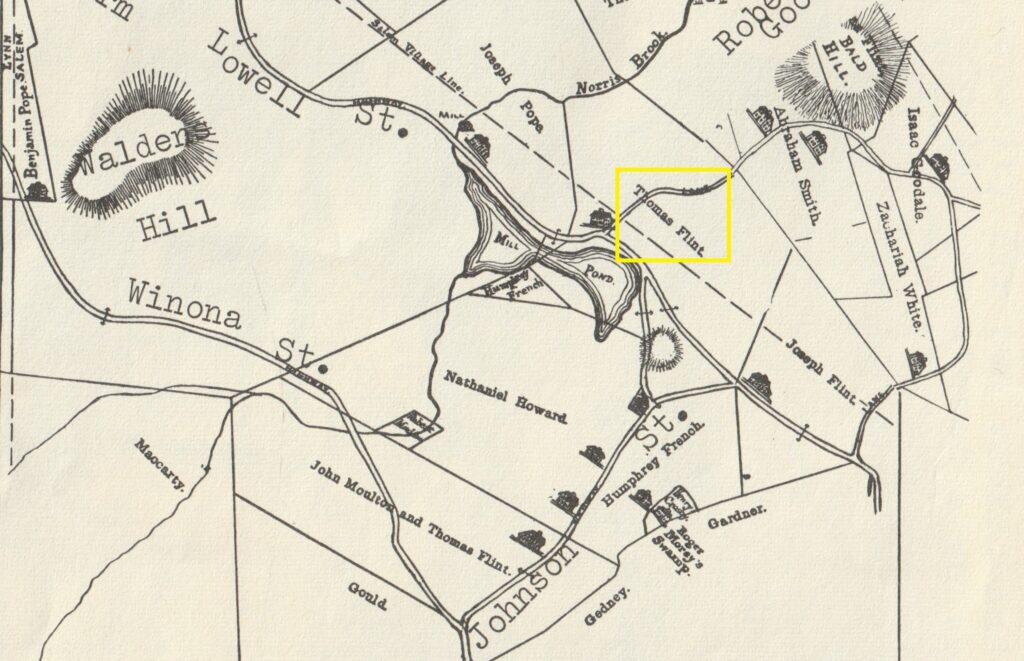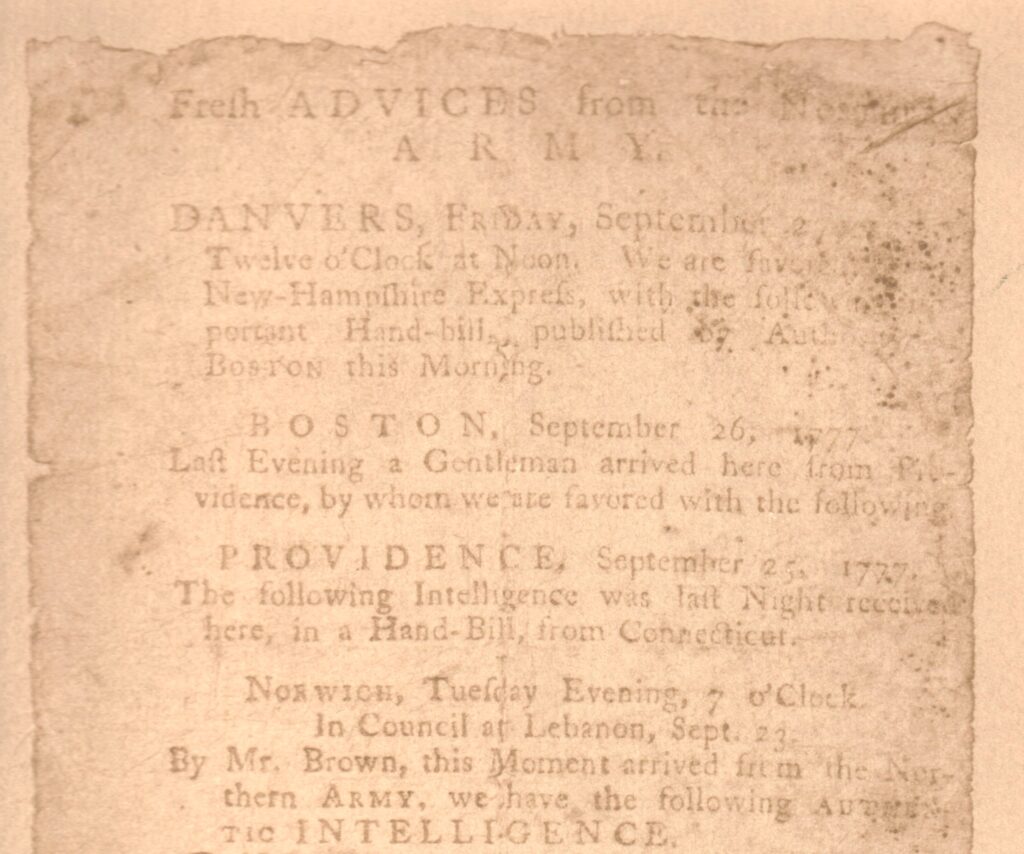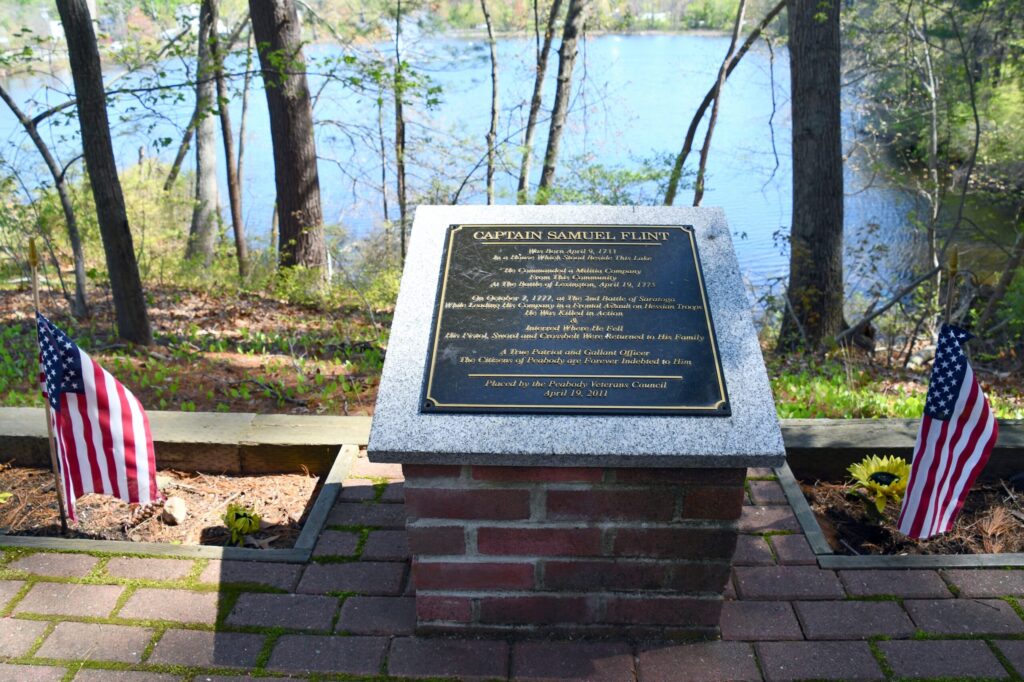Today’s Postcard from Peabody’s Past celebrates the birthday of Captain Samuel Flint, born on April 9, 1733 – 291 years ago today!
The Flint family emigrated to what is now Peabody, from Flint, a part of northern Wales, around 1640. Captain Flint’s grandfather, Thomas, served in the King Phillip’s War and was wounded in battle in 1675. He was also a respected builder, who built the first meeting house in Salem Village.
Captain Flint’s father, also named Samuel, proposed the petition separating Danvers (now Peabody and Danvers) from Salem. The family’s 17th century homestead in West Peabody survived until 1874, when it burned down.

Map of West Peabody, circa 1700, from The Peabody Story by John Wells.
Edited with yellow square to indicate Thomas Flint’s land.
Captain Samuel Flint was remembered as a leader and brave soldier during the American Revolutionary War. Captain Flint commanded one of the companies in Colonel Timothy Pickering’s regiment who fought at the Battle of Lexington on April 19, 1775.
Some of the West Peabody men under his command were Sgt. Asa Upton, Amos Buxton, Jr., Eleazar Goodall, Corp. Jona Sheldon, William Goodell, Eleazer Pope, Nathaniel Pope, Benjamin Russell 3rd, Jonathan Russell, Daniel Russell, Jethro Russell, Stephen Russell.
At first, it was believed Captain Flint died in that battle, but he returned home, much to the happy surprise of his family.

Excerpt from a Broadside on the First Battle of Saratoga, 1777
Published by Ezekiel Russell in Danvers (now the site of the Bell Inn in Peabody)
By August 1777, Captain Samuel Flint had led several Massachusetts militia companies. His last was under Colonel Samuel Johnson’s regiment at the Battle of Saratoga, also known as the Battle of Stillwater, New York (September 19 to October 7, 1777). Captain Samuel Flint died while fighting at the head of his company on October 7. Captain Flint was the only commissioned officer from Peabody to be killed in action. His family received mementos from their fallen son– his belt perforated by a bullet, his sword and watch, and by some reports, his pistol. On April 19, 2011, a memorial for Captain Flint was placed along Crystal Lake, near the bike path.

Photograph Courtesy of Cheryl Milliard
The American victory at Stillwater turned the tide in the war, cutting British General Burgoyne’s access to the Hudson River Valley. What is truly astonishing is that General Burgoyne surrendered. This was the first time the British Army had surrendered ever in its history. As a result of the victory, the French government formally offered their support to the American cause, which was desperately needed to win the war.
To learn more about the Battle – the Saratoga National Historic Park created a fascinating, interactive timeline. See link here – https://www.nps.gov/sara/learn/historyculture/1777-campaign.htm/
References
John Wells. The Peabody Story. Essex Institute, 1972, pages 55, 217, 223, 227.
Captain Samuel Flint and William Flint, by D. Webster King, Thirteenth Report of the Peabody Historical Society, 1908-1909 (Read originally April 19, 1898).
Massachusetts Soldiers and Sailors in the War of the Revolution. Prepared and Published by the Secretary of the Commonwealth, 1899.
Troy Smith. “Battle of Saratoga.” Accessed April 3, 2024. In The Digital Encyclopedia of George Washington. Retrieved from https://www.mountvernon.org/library/digitalhistory/digital-encyclopedia/article/battle-of-saratoga/#:~:text=The%20Battle%20of%20Saratoga%20fought,career%20of%20General%20George%20Washington.
